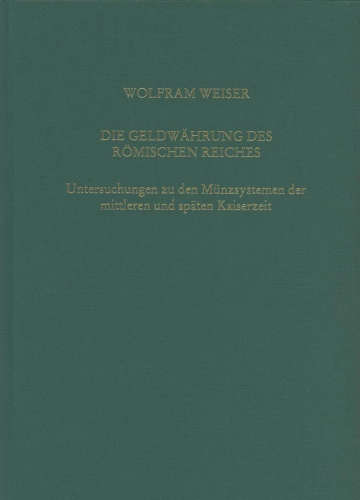A Great Numismatist’s Important Book Published Posthumously
by Johannes Nollé
Anyone, who has ever been involved in editing the work of a colleague having passed away before time, knows very well how much work such an undertaking requires and what doubts remain at the end. Very often, such an editor or executor ends up concluding that it would have been better not to have done it. At least from my point of view, Johannes Heinrichs and Werner Eck should not come to such a summary of their devoted, meritorious and sensitively handled work
Both have taken on the not easy task of compiling those writings which the well-known and excellent numismatist Wolfram Weiser was not able to complete, due to the rapid decline of his health. Just one year after the death of him they present his last studies in a book entitled ‘Die Geldwährung des Römischen Reiches. Untersuchungen zu den Münzsystemen der mittleren und späten Kaiserzeit (The Currency of the Roman Empire. Studies on the Coinage Systems of the Middle and Late Imperial Period)’. The Habelt publishing house in Bonn being indispensable for German classical studies has brought out this book in its Antiquitas Series 1 with the ISBN 978-3-7749-4391-9.
The work done by the two Cologne Classical scholars is a recognition and a lasting monument of gratitude for Wolfram Weiser’s many years of attractive teaching Numismatics at the Institute of Classical Studies at the University of Cologne. With his enthusiasm for coins, Wolfram Weiser created an awareness of the importance of numismatic research among many academics and won many interested people and friends for the history of money and the haptically tangible coins. In doing so, he has also shown new methodological paths and made clear the importance of understanding coins precisely with the help of the entire field of Classical studies and then integrating the new findings in the field of numismatics into the other research fields of Classics. I am one of the ancient scholars who were won over to numismatics by Wolfram Weiser. I still remember very well how my friend Wolfram told me one day: “You cannot write a history of the Pamphylian city of Side only with literary sources, papyri and inscriptions. You also, and especially, need the city’s coins for such a project!”. He saw this correctly, and so an ancient historian, classical philologist and epigraphist also became a numismatist.
Wolfram Weiser, as his writings show, mastered and researched ancient numismatics to its full extent. One of his focal points was the numismatics of Asia Minor, especially the coinage of Greek cities during the imperial period. His dissertation dealt with the imperial bronze coins of the Bithynian city of Nikaia. Several volumes of the Cologne series ‘Inscriptions of Greek Cities of Asia Minor’ contain small but extremely valuable city corpora from Wolfram Weiser’s pen. He was also interested in the development of currency in the High Imperial and Late Antique periods and in the Gallic Roman Empire. He presented a catalogue of the Ptolemaic bronze coins in the collection of the Institute of Classical Studies at the University of Cologne and assisted Angelo Geißen in completing the corpus work of the Alexandrian imperial coins also housed in this university collection: Wolfram Weiser was involved in the compilation of volume 4 of this series and finally produced the index breaking down this monumental work. Furthermore, another focus of Wolfram Weiser’s interest was the Byzantine lead seals and the Byzantine administration that appears on them.
In all this research, Wolfram Weiser showed himself to be a scholar who broke new ground in thought. He hated to delve further into well-trodden paths. Such an approach always carries the risk of going astray from time to time, but errors must first be refuted, and when scholars were confronted with them, they take research further. This also applies to the content of the book presented by Werner Eck and Johannes Heinrichs, which every numismatist dealing with Imperial and especially Late Roman numismatics should have at hand, if not in his own library. Particularly valuable are the treatments of Diocletianic and Constantinian monetary policy. Everything is stimulating, some things may be seen differently, but the combination of numismatic findings with literary and epigraphic sources is of lasting value, methodically and in terms of content.
It only remains to say that, thanks to various printing cost subsidies, the book can be purchased for an acceptable price of 60 euros.





